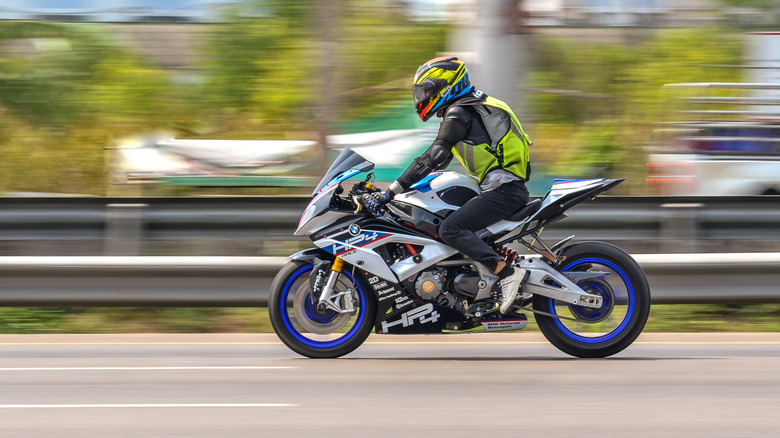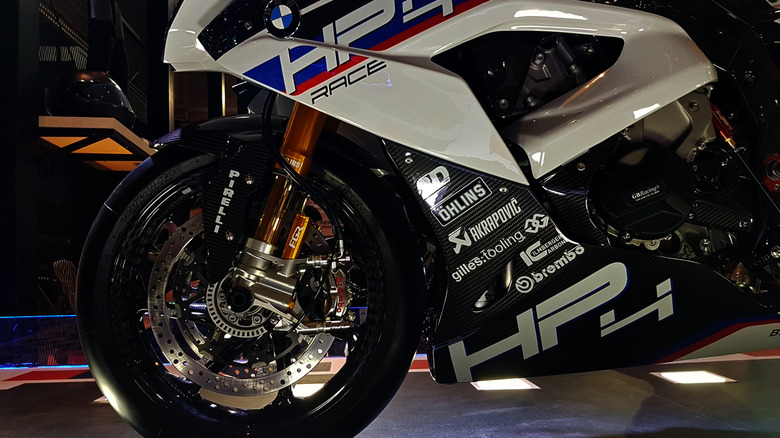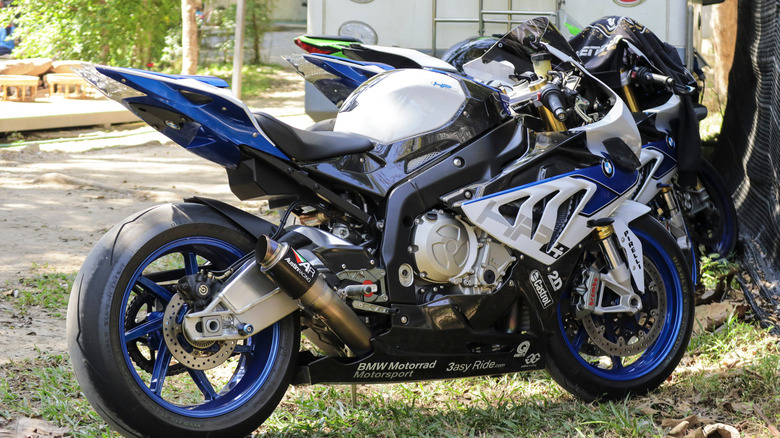Why The BMW HP4 Race's Engine Has Such A Low Life Expectancy
The BMW HP4 Race is engineered as a track-only machine that pushes performance to the limit. Underneath the carbon fiber frame (which might be banned soon) is a hand-built 999cc inline-four that produces around 215 horsepower at 13,900 rpm, a figure on par with World Superbike and endurance racing engines, helping the HP4 Race achieve some very blistering speeds. To achieve this level of output, BMW uses lightweight components such as milled connecting rods, a lightened crankshaft, and race-spec camshafts. These modifications deliver blistering acceleration and top-end speed, but at the cost of durability.
Unlike road bikes that prioritize reliability over years of use, the HP4 Race's engine is tuned for maximum performance during short, intense intervals. That's why BMW officially sets its service life at 5,000 km (roughly 3,100 miles). At that point, the engine isn't rebuilt but replaced entirely, reflecting how heavily stressed its internals become during operation. For track-day riders, this translates to about 12 days of hard riding before a swap is needed.
To put this into perspective, the standard BMW new vehicle warranty, which specifically excludes this bike, is set at 36,000 miles (or 3 years, whichever comes first). This is roughly 12 times the service life of the HP4. But it should be noted that the 5,000 km threshold is a manufacturer-set guideline and not a strict mandate, and riders do not necessarily have to follow it. It's best practice and will keep your bike from experiencing performance issues, but the engine is not necessarily going to break down as soon as you cross 5,000 km.
Why the engine wears out so quickly
The short lifespan comes down to mechanical stress and heat management. Racing engines are pushed far closer to their limits than production models, with high compression ratios and extreme rpm ranges. Over time, this leads to worn valve guides, dried valve seals, and issues like excessive oil consumption. Compression loss and piston-to-cylinder clearance shifts also occur much faster than on consumer motorcycles. BMW Motorrad compares the HP4 Race's endurance to World Superbike machines, which are inspected after only 600 to 900 miles of racing.
In endurance events, engines are often swapped after just 2,300 miles of continuous use. By those standards, the HP4 Race's 3,100-mile lifespan fits within the norm for competition-level bikes. It's simply the trade-off of extracting every ounce of performance. To guarantee consistency, BMW doesn't leave rebuilding to local workshops; the replacement units arrive from the factory pre-run and performance certified, ready for immediate use.
Who this bike is really for
BMW limited production of the HP4 Race to just 750 units worldwide, with about 80 expected in the U.S., making it a highly exclusive machine. Its $78,000 price tag covers far more than exotic carbon fiber and MotoGP-grade suspension; it buys entry into a different class of motorcycle ownership. Riders need access to a racetrack and the budget to maintain it, which includes potential engine replacements and consumables like tires and brakes, all of which wear faster under racing conditions.
Even so, BMW made sure the bike is as close to a factory racer as money can buy. From Öhlins FGR 300 forks and Brembo GP4 PR brakes to advanced electronics with 15 levels of traction and engine braking control, it's loaded with hardware straight from the world's top paddocks. No wonder it's considered one of the best motorcycles BMW has ever made. The short engine life is a part of the package: it's the cost of riding something that blurs the line between WorldSBK machinery and a customer-available superbike. For the small group of buyers, the low life expectancy is simply another reminder that the HP4 Race is built for the track, not the long road ahead.


